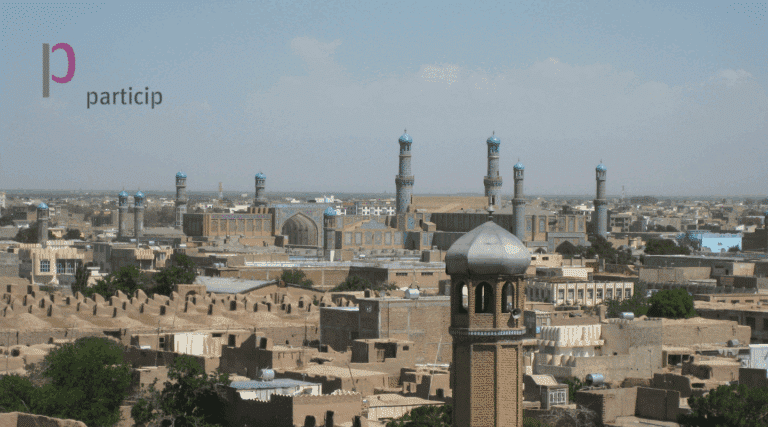How Particip is impacting healthcare in Afghanistan using SurveyCTO


Meet Particip
Particip Gmbh was founded in 1989. Today, it is an independent, internationally recognized consulting firm that offers expertise and know-how gained in over 2,000 change management assignments worldwide. Their services include monitoring and evaluation (M&E), capacity and organizational development, technical assistance, policy, studies, surveys, and analyses.
Offices: Headquartered in Freiburg, Germany, with offices in Brussels, Belgium, Kabul, Afghanistan, and Belgrade, Serbia.
Sector: Global health, international development
Use case: National health survey, monitoring and evaluation
Employees: 95
Features used: Advanced offline, case management
Website: https://www.particip.de/
The Challenge: Two separate surveys at the same time in the same home with no reliable Internet
Measuring health across an entire country is never simple—especially in a country as large and complex as Afghanistan.
In 2024-25, Particip, in collaboration with consortium partner KIT, undertook a technically complex and high-stakes assignment to measure critical health indicators in Afghanistan through the Afghanistan Health Survey. This project was supported by Management Sciences for Health (MSH) through the USAID-funded Assistance for Families & Indigent Afghans to Thrive (AFIAT) Project.
The goal? To understand the current status of health and health services in Afghanistan, and empower data-driven decision making for healthcare on a national and provincial level.
The method? An in-depth, population-based survey measuring key indicators related to maternal and child health, fertility levels, health service utilization, healthcare expenditures, patient care quality, and nutrition outcomes.
The survey aimed to interview both men and women, and to measure children’s anthropometric indicators across thousands of households from all 34 of Afghanistan’s provinces, ranging from urban centers to the most remote, hard-to-reach areas.
But conducting a survey of this scale in this part of the world proved to be a uniquely complicated endeavor:
- First, the local authorities required that all household interviews be concluded in a single visit, precluding any follow-up or repeat visits.
- Second, gender norms and cultural practices in Afghanistan meant that the women in a household could only be interviewed by female enumerators, and men by male enumerators. Moreover, these interviews had to be conducted in separate physical spaces within the household. This necessitated deploying gender-paired data collection teams, a female enumerator and a related male enumerator (known as ‘mahram’) per household, to facilitate concurrent, private interviews during the same visit.
- Third, because the survey would be conducted across all 34 of Afghanistan’s provinces, many areas had connectivity challenges, including unreliable or nonexistent internet infrastructure.
- Finally, there was one more layer of complexity: Initial listing information for each household had been previously provided by the head of household weeks before the actual survey began. If there had been any changes in the household since then, the household listing data would need to be updated at the time of the interview so that every eligible member could be properly included in the study.
Gathering high-quality data in a timely and cost-effective way under these circumstances presented Particip with a serious challenge!
Initially, the team considered several potential workarounds to navigate the complex survey implementation environment. Each approach, however, introduced significant trade-offs in terms of efficiency, data integrity, and operational feasibility:
- Pen-and-paper surveys, which would allow for interviews to be conducted at the same time by different data collectors without an internet connection. But paper forms are slow, tedious, require costly and time-consuming data entry, and are at risk of all kinds of serious data quality and security problems, from being lost or physically damaged to having their sensitive data accessed by the wrong people.
- Another potential solution was collecting data in the offline mode to interview all respondents at the same time. But this setup also presented a major technical hurdle: household listings often required real-time updates based on confirmation from male heads of household. These updates, critical for ensuring eligible respondents were included, would have to be manually transferred from the male enumerator’s tablet to the female enumerator’s device mid-interview, creating both logistical complexity and risk of data inconsistency.
- A third alternative was to rely on one digital device per household. While this approach reduced the technical burden of synchronizing updates, it also meant that male and female respondents could not be interviewed in tandem. Female respondents would have to wait until the male survey was completed, effectively doubling the total interview time required per household, which would substantially increase overall fieldwork duration and costs.
The Solution: SurveyCTO’s offline case management features
Simultaneous but separate interviews. Multiple devices. Forms that often needed to be updated in real time. Particip decided to explore data collection tools to see if they could find a solution that would meet these demands.
“We were trying to capture lightning in a bottle – a single solution that could meet all our operational and contextual requirements,” says Particip Project Coordinator Mridulya Narasimhan.
Some team members had prior experience with SurveyCTO, though not at this scale or capacity. But they quickly discovered that SurveyCTO’s offline case management features were a perfect fit.
With this functionality, survey forms can be updated and transferred between data collectors in real time—even without an internet connection. As a result, updates made by male interviewers, such as modifications to household listings confirmed by heads of households, could be instantly reflected on the female interviewer’s device during the same visit.
Using a data collection tool that could work within the project’s parameters meant Particip could capture high-quality data while keeping survey time to a manageable level 2.5 hours per household—and ultimately keep survey costs within budget.
Here’s how SurveyCTO’s offline case management supported this workflow
SurveyCTO’s advanced offline features can be combined with our case management functionality to create a seamless multi-form workflow—and that’s exactly what Particip did.
Their survey flow went like this:
- Male data collectors would get consent to interview people in the home from the male head of household.
- The male enumerator then reviewed the pre-existing household listing and directly any changes, particularly regarding the presence of women and children, with the head of household.
- Any updates about women or children in the home were then transferred to the female enumerator’s device via SurveyCTO’s offline case transfers functionality.
- Once all updates were received, female data collectors would interview women one by one in the household.
These real-time updates to information on women and children in the home were made possible using SurveyCTO’s offline case transfers feature, which enables users to receive updates to existing cases from other data collectors entirely offline.
Ultimately, this easy transfer of case data ensured that male and female data collectors were able to have completely separate interviews with their respective respondents while adhering to cultural norms and ensuring the highest-possible quality of data.
The Results
Using SurveyCTO’s advanced offline features with case management, Particip has been able to survey over 17,000 households across Afghanistan as of March of 2025.
They were also able to halve the time needed for data collection, reduce costs associated with surveyors conducting interviews, and lessen the financial burden on heads of households who had to take time from work to complete these interviews.
The data from this nation-wide survey will serve as a critical evidence base for governments and international aid and donor organizations on health priorities for Afghanistan, paving the way for improved health outcomes, a more resilient healthcare system and ultimately a brighter future for millions of people.

